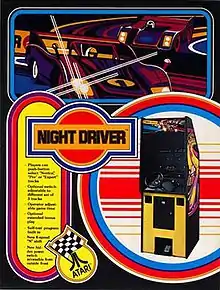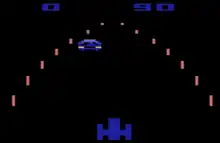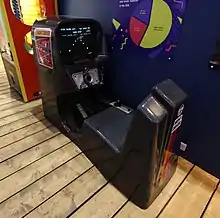Night Driver (video game)
Night Driver is an arcade video game developed by Atari, Inc. and released in the United States in October 1976. It's one of the earliest first-person racing video games and is commonly believed to be one of the first published video games to feature real-time first-person graphics. Night Driver has a black and white display with the hood of the player's car painted on a plastic overlay. The road is rendered as scaled rectangles representing "pylons" that line the edges.
| Night Driver | |
|---|---|
 Arcade flyer | |
| Developer(s) | Atari, Inc. |
| Publisher(s) | |
| Designer(s) | Dave Shepperd s/w Ron Milner Steve Mayer Terry Fowler (hardware) |
| Platform(s) | Arcade, Atari 2600, Commodore 64 |
| Release | Arcade Atari 2600Commodore 64
|
| Genre(s) | Racing |
| Mode(s) | Single-player |
| Arcade system | 6502 @ 1.008 MHz |
Two arcade cabinet styles were manufactured: upright and sit-down. The upright version has a blacklight installed inside the cabinet which illuminated the bezel.[5][6]
Atari published a color version for the Atari Video Computer System in 1980.
Gameplay
The player controls a car which must be driven along a road at nighttime without crashing into the sides of the road as indicated by road side reflectors. The game is controlled with a single pedal for the accelerator, a wheel for steering and a four-selection lever for gear shifting. The coin-operated game had a choice of three difficulties (novice, pro and expert), which the player could select at game start. The turns were sharper and more frequent on the more difficult tracks. As play progresses, the road gets narrower and more winding.
The game length is 50, 75, 100 or 125 seconds based on an internal setting.[5] After 300 points, a player is awarded bonus time equal to game time, but the score wraps around back to zero at 1000 points, so it is possible to reach 300 points more than once.[7] Due to the additional points received for more difficult play, playing on the expert setting is actually the easiest to achieve extra time once a player has mastered the game.[7]
The car the player is driving is not actually drawn in the game, but is printed on plastic insert in front of the monitor.
Development
When he began working on video games, Atari founder Nolan Bushnell had originally planned to develop a driving video game inspired by Speedway (1969),[8] a first-person driving electro-mechanical game manufactured by Chicago Coin,[9] in turn a licensed version of Kasco's Indy 500 (1968).[10][11] However, Bushnell had concerns that a driving video game might be too complicated for Al Alcorn's first game, so they instead decided to develop a simpler game, Pong (1972).[12] Night Driver has similarities to arcade driving electro-mechanical games, which had a scrolling road rather than a fixed view.[13]
The development of Night Driver was led by Dave Shepperd at Atari, who was given an assignment to develop a first-person driving video game. Shepperd said that he "was given a piece of paper with a picture of a game cabinet that had a small portion of the screen visible" which he recalls being possibly "a German game" but "never saw the game play" other than "that there were a few little white squares showing". Shepperd used that concept to develop Night Driver. That the car is driving at night provided an excuse for the minimal graphics, as most features (like the street and buildings) aren't visible in the dark.[14] While he did not know the title of the German game at the time, it was later identified as the coin-op Nürburgring 1, a first-person driving video game released earlier in 1976.[15][16]
Atari used some of the leftover arcade cabinets from Hi-way (1975), a top-down vertically scrolling racing game, for Night Driver.[13]
Release
The arcade game began production in October 1976.[2] Atari demonstrated the game at the AMOA show in November 1976, where it was one of several driving games demonstrated by Atari along with Sprint 2 and Namco's electro-mechanical F-1; the most talked-about driving game at the show was F-1. Night Driver also drew comparisons to Midway Manufacturing's Midnight Racer (later re-branded Datsun 280 ZZZAP) at the same show and an earlier German night driving video game (Nürburgring 1) demonstrated at the German IMA show in Spring 1976.[17]
Ports

Atari released a port for the Atari VCS (later renamed to the Atari 2600) in 1980. It was programmed by Rob Fulop,[18] who added color, displaying the player vehicle, additional vehicles the player must avoid, and showing houses and trees along the sides of the road. The paddle controller steers the vehicle; holding the button accelerates.[19] It is not possible to shift gears in this version. There are eight variations, some of which are timed and the player tries to score as much as they can in 90 seconds.[20]
Commodore published a version for the Commodore 64 in 1982.[21]
Reception
In Japan, it was the tenth highest-grossing arcade video game of 1976.[22]
In the United States, according to Play Meter magazine, Night Driver was the sixth highest-earning arcade video game of 1977.[23] According to RePlay magazine, it was the seventh highest-earning arcade video game of 1977.[24] Play Meter later listed it as the ninth highest-grossing arcade game of 1978,[25] and the eleventh highest arcade video game of 1979.[26]
The Atari VCS version sold 161,352 copies in 1980, becoming one of the top five best-selling Atari VCS games that year, and went on to sell over 1.9 million copies by 1983.[27] Video Games Player magazine reviewed the Atari VCS version, rating the graphics and sound a B, while giving the game an overall A− rating.[28] In 1995, Flux magazine ranked the arcade version 59th on their "Top 100 Video Games".[29]
Legacy

Two other first-person racing games were released shortly afterwards: Midway's Midnight Racer in November 1976 (later branded as Datsun 280 ZZZAP in March 1977) and Micronetics' Night Racer in March 1977.[30]
Bill Budge wrote a Night Driver clone for the Apple II using the same name as the original.
References
- Akagi, Masumi (13 October 2006). ナムコ Namco. p. 51. ISBN 978-4990251215.
{{cite book}}:|work=ignored (help) - "Production Numbers" (PDF). Atari. 1999. Retrieved 19 March 2012.
- "Video Game Flyers: Night Driver, Atari, Inc. (Germany)". The Arcade Flyer Archive. Killer List of Videogames. Retrieved 22 March 2021.
- "Night Driver (Registration Number PA0000174628)". United States Copyright Office. Retrieved 1 June 2021.
- "Owner's Manual". 1978. Retrieved 7 November 2012.
- "Arcade Museum". Retrieved 7 November 2012.
- "Night Driver Museum Entry". Retrieved 7 November 2012.
- Bushnell, Nolan; Weaver, Christopher (2017-11-17). "Nolan Bushnell: Transcript of an interview conducted by Christopher Weaver" (PDF). Lemelson Center for the Study of Invention and Innovation. Smithsonian Institution. p. 33. Retrieved 2021-05-20.
- Ramsay, Morgan (2012-06-08). Gamers at Work: Stories Behind the Games People Play. New York: Apress. p. 24. ISBN 978-1-4302-3352-7.
- "Kasco Indy 500 coin operated mechanical arcade driving game". Pinball Repair. Retrieved 16 April 2021.
- Smith, Alexander (19 November 2019). They Create Worlds: The Story of the People and Companies That Shaped the Video Game Industry, Vol. I: 1971-1982. CRC Press. pp. 119–20, 188–91. ISBN 978-0-429-75261-2.
- Pescovitz, David (1999-06-12). "The adventures of King Pong". Salon. Archived from the original on 2008-03-07.
- Barton, Matt (8 May 2019). Vintage Games 2.0: An Insider Look at the Most Influential Games of All Time. CRC Press. p. 73. ISBN 978-1-000-00092-4.
- "Racing Game Pioneers". 11 February 2012. Retrieved 7 November 2012.
- "Nuerburg Ring Game". Retrieved 7 November 2012.
- "Game Review". Retrieved 7 November 2012.
- "Sexton Star of MOA Seminar: Video". Play Meter. Vol. 2, no. 14. December 1976. pp. 20-26 (23-6).
- Interviews. Rob Fulop
- Night Driver text Atari Mania
- Night Driver text Atari Mania
- "Night Driver (1982) by HAL Laboratory C64 game".
- "本紙アンケー 〜 ト調査の結果" [Paper Questionnaire: Results of the Survey] (PDF). Game Machine (in Japanese). No. 65. Amusement Press, Inc. 1 February 1977. pp. 2–3.
- "Top Arcade Games". Play Meter. November 1977.
- "Profit Chart". RePlay. November 1977.
- "The 'Winners' of '78: Top Arcade Games". Play Meter. 1978.
- "The Winners of '79: Top Videos". Play Meter. 1979.
- Cartridge Sales Since 1980. Atari Corp. Via "The Agony & The Ecstasy". Once Upon Atari. Episode 4. Scott West Productions. August 10, 2003. 23 minutes in.
- "Software Report Card". Video Games Player. Vol. 1, no. 1. United States: Carnegie Publications. September 1982. pp. 62–3.
- "Top 100 Video Games". Flux. Harris Publications (4): 31. April 1995.
- Akagi, Masumi (13 October 2006). アーケードTVゲームリスト国内•海外編(1971-2005) [Arcade TV Game List: Domestic • Overseas Edition (1971-2005)] (in Japanese). Japan: Amusement News Agency. p. 124. ISBN 978-4990251215.
External links
- Night Driver at the Killer List of Videogames
- Night Driver at Arcade-History.com
- Atari 2600 Night Driver at Atari Age
- Arcade Night Driver manual